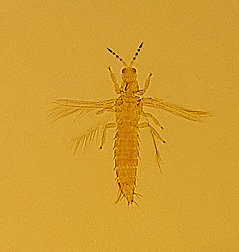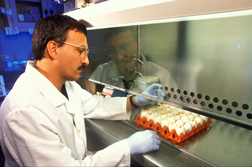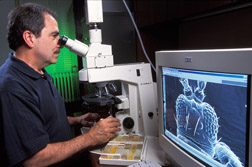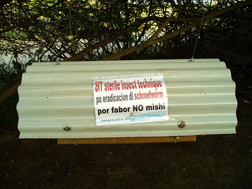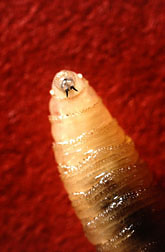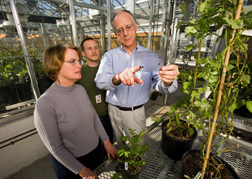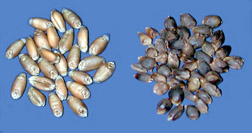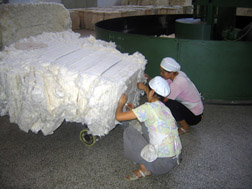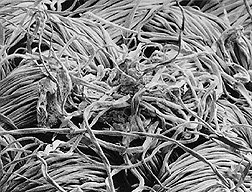ARS Experts as Firefighters
Our scientists respond to international
agricultural problems that affect the United States
Most of the time when you think of scientists solving problems, you picture months or years of experiments and study. But sometimes ARS scientists are called on to be firefighters—helping cool down international agricultural hot spots that are critical to the United States and the world.
On December 26, 2004, the freighter Yarmouth was stuck dockside in Béjaia, Algeria, unable to unload 18,600 tons of U.S. durum wheat because the Algerian government feared the shipment was infected with Karnal bunt, a contagious fungus that infects wheat.
Many countries require either immediate quarantine of wheat exports from areas reporting the presence of Karnal bunt or phytosanitary guarantees that the fungus is not present in a shipment. Several outbreaks have occurred in the United States since Karnal bunt was first reported here in 1996, but the last time was in 2001.
With a large but volatile wheat export market like Algeria, which can bounce from $20 million to $100 million a year, at stake, it was essential that the United States provide clear, scientific assurance that this shipload of wheat would not put Algerian agriculture at risk and that routine U.S. Karnal bunt precautions are strong enough to keep other countries safe.
With time of the essence—it is costly for ships to idle in port, not to mention the damage to U.S. wheat’s reputation—USDA’s Foreign Agricultural Service (FAS) and Animal and Plant Health Inspection Service (APHIS) and Algerian authorities turned to ARS’s leading Karnal bunt expert, mycologist Lisa Castlebury, with the Systematic Botany and Mycology Laboratory at the Beltsville (Maryland) Agricultural Research Center (BARC).
Castlebury’s day-to-day job is researching the systematics of plant pathogenic fungi, especially the Tilletiales (bunt fungi) and Diaporthales (chestnut blight)—how these fungi operate biologically. Such basic information helps to accurately identify disease and quarantine pests and provides the foundation from which to develop effective disease-management strategies.
“Karnal bunt can be difficult to distinguish from a look-alike but harmless fungus usually associated with ryegrass,” Castlebury explains. “They can be easily confused, especially in situations where only a few spores are present, and the result can be needless and costly quarantines.”
|
|
But Castlebury is one of the scientists who described the ryegrass fungus and detailed features that distinguish it from Karnal bunt fungus. She also helped develop one of the tests used to distinguish the two.
With hopes that she could convince that country’s authorities and free the wheat shipment, Castlebury was flown to Algeria.
“I looked at samples and slides prepared by the Algerian quarantine scientists and met with the Algerian Secretary General of the Ministry of Agriculture and his experts, explaining the science behind my identification methods and just how reliable the information really was,” Castlebury says.
On February 2, Algeria allowed the shipment to be unloaded.
“Dr. Castlebury’s expertise was essential to solving the technical aspects of this problem,” says Karen Z. Ackerman, APHIS phytosanitary manager/trade issue director for this region.
“Since Algeria is the world’s largest durum wheat importer, restoring Algerian confidence in U.S. wheat supplies was extremely important to our wheat farmers,” adds Michael J. Fay, the U.S. agricultural attaché, who coordinated the U.S. response.
Thrips Take a Trip—to Cuba
Sometimes it is not a country that an ARS scientist must convince, but rather world opinion. Such was the case in 1996, when Cuba accused the United States of releasing crop-destroying insects called “Thrips palmi” during an authorized overflight by a U.S. narcotics crop-eradication plane from Florida to Bogota, Colombia.
T. palmi, which can damage a wide variety of crops, including beans, cantaloupe, melons, peppers, potato, and soybeans, was first described in Indonesia in the 1920s.
Cuba charged in the United Nations that the United States released these thrips from the plane, accidentally or deliberately, to spoil their sugarcane crop—an act of biological warfare. A Biological Weapons Convention consultative meeting/hearing was held in Geneva in August 1997.
There was never any question that at the end of 1996 T. palmi were being found in Cuba. But how did they get there?
To answer that question, the United States called on entomologist Sueo (Steve) Nakahara, now retired from ARS’s Systematic Entomology Laboratory (SEL) at BARC. The lab is one of the foremost authorities on agronomic insect identification. Many countries submit samples to it and rely on the staff’s expertise.
Nakahara began by checking the scientific literature for records of T. palmi in the Western Hemisphere. It was first found in Martinique in 1985 and reached Florida by the end of 1990. Then he combed the U.S National Collection for thrips that had been sent at various times from a variety of locations for identification by SEL.
He combined that data with his expert knowledge of the behavior and spread of thrips and projected when a natural spread would have reached Cuba.
“When Steve compared his projected arrival time with when the Cubans reported finding the thrips, the thrips were right on schedule,” explains SEL research leader M. Alma Solis. “That’s part of the value of having a lab like SEL. Although we do basic research, we are the resource for information and studies that provide answers like the one needed here.”
|
|
Animal Disease Experts
The ARS Southeast Poultry Research Laboratory (SPRL) in Athens, Georgia, has taken on a special role in international efforts to deal with one of today’s most pressing animal health issues: avian influenza (AI). In April 2005, the United Nations Food and Agriculture Organization and the World Organisation for Animal Health launched the New Worldwide Avian Influenza Network (known as “OFFLU”) to coordinate reference laboratories focusing on AI in animals and those focusing on human influenza. The network, of which SPRL is part, is designed to speed up exchange of scientific data among leading diagnostic and research institutions.
“ARS brings unique resources and facilities to the table, like being able to do rapid sequencing to identify changes in AI viruses and vaccine safety and efficacy studies,” says David E. Swayne, director of the Athens lab. “We need to have the experts linked together if we are going to expand our scientific knowledge and improve efforts to control or eradicate AI around the world.”
ARS AI experts have also been in demand by countries facing this critical issue. In particular, David L. Suarez, research leader of the Exotic and Emerging Avian Viral Diseases Research Unit in Athens, has been lending expertise to several Southeast Asian and eastern European countries.
“Funding has come from the United States, host countries, and others for me to help other countries set up practical, effective systems and provide guidance on what types of bird vaccines they need,” says Suarez.
For example, in fall 2005, Romania asked Suarez to evaluate its laboratory capabilities and provide technical suggestions after they confirmed cases of H5N1 AI in birds there. In December 2005, he traveled to Vietnam to teach a course on real-time PCR diagnostic tests for AI strains—tests he helped develop.
|
|
Sensing Screwworm
While ARS’s help with AI has been preventive, other cases have involved a more active role in solving an animal disease problem.
When Aruba, a tiny island in the Caribbean, had an outbreak of screwworm in March 2004, it contacted ARS remote-sensing specialist Pamela L. Phillips, who works with the Mexican-American Commission for the Eradication of Screwworm (COMEXA) from the ARS Screwworm Research Unit in Panama. ARS’s invention of the sterile male insect release control method was the basis for eradication of screwworm in the United States in 1982.
ARS continues to research ways to eradicate screwworms, but in other countries rather than here, because screwworm has been eradicated south to the barrier zone in Panama.
Aruba knew it needed immediate help before the screwworm outbreak problem grew worse. Not only was the local livestock industry endangered, but there was concern for the country’s number-one industry, tourism, because screwworms can cause untold devastation to all warm-blooded animals, including humans.
“Because Aruba is only 112 square kilometers and has high trade winds, we couldn’t use our conventional dispersal method of aerial release of sterile male screwworm flies,” Phillips explains. “But I had come up with a new method where I use satellite imagery to identify areas that would be favorable habitat to set out ground-release chambers for sterile screwworm pupae.”
COMEXA agreed to try this new method for the first time, and the Aruban government officially asked the U.S. government for assistance.
First, Phillips identified the favorable habitats on LANDSAT satellite data, along with prevailing wind directions and locations where screwworm infested animals had been found.
“Then we stayed in contact with Aruban veterinary teams to monitor the pattern of positive screwworm cases and to identify additional areas for ground release as needed,” Phillips says.
Ground releases began on June 7, 2004. “The last screwworm case in Aruba was reported on October 13, 2004, but we continued releasing sterile flies until December 16, three fly life cycles after the last positive find,” Phillips recounts.
An Objective Voice
ARS scientists aren’t always called on to travel to a foreign country to help cool off an international hot spot; sometimes others come to us.
When Brazil, the largest buyer of U.S. wheat in South America, banned its import in 2000 because of concerns about wheat seed gall nematode, FAS and APHIS turned to David Chitwood, zoologist and research leader with the ARS Nematology Laboratory at BARC.
These nematodes had been widely found in the United States until wheat cleaning—which easily and completely removes them—became customary. The last find was reported from Virginia in 1975.
But Brazil believed that the nematode was still present in the United States and didn’t want it in Brazil.
“We had a team of Brazilian nematologists, plant pathologists, and an agricultural trade expert spend a week here looking at U.S. wheat for the nematode. The Federal Grain Inspection Service shipped in samples from all around the United States. Each wheat sample was found to be free of plant parasites,” Chitwood says, who hosted along with ARS plant pathologist Lynn Carta.
What capped the controversy was when Chitwood and ARS microbiologist Zafar Handoo went through the U.S. Nematode Collection, which their lab oversees, and found a sample of a seed gall nematode collected from Brazil in the 1950s, proving that Brazil is already home to at least the same genus of problem nematodes. The identification couldn’t be any more specific because the sample nematodes were juveniles.
|
|
Brazil lifted the import ban in early 2001.
“They came to us because we have the most expertise in identifying nematode species,” Chitwood explains. “They trusted ARS as an objective scientific voice. They felt comfortable that ARS, as a scientific, nonregulatory agency, doesn’t have anything at stake in a trade issue.”
Objective expertise was also what prompted the Maine Department of Agriculture to contact ARS chemist Robert Owens, with the Molecular Plant Pathology Laboratory at BARC, for help in the spring of 1996. A shipment of Maine seed potatoes was prohibited from being planted in New Brunswick, Canada, because it was believed to be infected with potato spindle tuber viroid.
“I knew this farmer and his operation and knew that he was working with clean stock from tissue culture, so I couldn’t believe he would have seed infected with this serious pathogen,” recounts Terry Bourgoin, director, division of plant industry, Maine Department of Agriculture. “Potato spindle viroid is not a quarantine issue for the United States, so APHIS wasn’t involved. I needed an expert familiar with this pathogen to help us prove that the operation was clean and that the testing was the problem.”
The crux of the matter was what type of test would be used to determine whether or not potato spindle tuber viroid was present. Ag Canada had certified several private laboratories to test RNA samples. A test had found a band of RNA that might have been potato spindle tuber viroid.
“We retested the potatoes using a much more sensitive and specific test for viroid nucleic acids and found no trace of potato spindle tuber viroid,” Owens says.
|
|
Then Owens explained the efficacy of the test methods and his results to the Maine Department of Agriculture and Ag Canada.
“Ag Canada changed its decision because they saw ARS as an objective scientific authority, equal to their organization,” Owens says.
Eventually, the grower received a financial settlement for his potatoes, which had been destroyed.
That fall, a meeting was organized by the Canadians with the United States and Mexico to discuss acceptable testing standards. Owens attended as a subject expert.
“It’s not ARS’s job to be the first responder when a crop shipment gets stopped at a border, but we are seen as a source of authoritative science,” Owens says.
Bourgoin adds, “Without Bob’s help, not only would that grower have been stuck for the financial loss of the seed potatoes, he would have been prohibited from shipping to Canada for several years, and Maine’s whole seed potato export industry would have been in jeopardy.”
|
|
The Cotton Concurrence
Quarantine and disease are not the only types of international fires ARS helps to extinguish.
An ARS team led by Xiaoliang “Leon” Cui, a cotton technologist, and Patricia Bel, a textile engineer, both at the ARS Southern Regional Research Center in New Orleans, Louisiana, ensured that U.S. cotton producers would continue to be able to sell their product to the People’s Republic of China, a market worth about $733 million a year.
In 2002, China notified the World Trade Organization that it was going to institute new mandatory standards for short fiber content and white-speck nep count in cotton bales as measured by tests not currently used in international trade. “White-speck neps” are small knots of tangled fibers that can cause a dye defect and reduce fabric quality.
Since the new tests would be time-consuming and costly and would only be required in China, they represented a potential trade barrier. This concerned both USDA’s Agricultural Marketing Service (AMS), which guides cotton quality standardization in the United States, and the National Cotton Council of America. So the two groups turned to ARS for help in evaluating the new China test before the new regulations would take effect. Cui is a leading expert in measuring cotton fiber length, and Bel is an expert in measuring neps.
But before the ARS scientists could even begin their evaluation of the new tests, they first had to obtain the test instrument that was going to be used by the Chinese. Then they had to translate the test standards from Chinese into English.
In just a matter of weeks, the ARS scientists finished experiments to see how reliable China’s methods were. They also established equations using results from conventional laboratory fiber testing methods to predict the fabric quality results if Chinese cotton were tested by conventional U.S. methods and then compared to U.S. cottons.
Then Cui organized a briefing for Chinese cotton experts. He explained the current internationally recognized test methods, the reliability of those methods, and how they matched up with the proposed new tests. Armed with research results and technical advice from ARS, AMS was able to quickly respond to Chinese government officials regarding technical aspects of the new requirements.
The Chinese government then postponed implementation of the new standards and soon announced that the Chinese cotton classification system would be reformed. This reform will not only help China modernize its classing system, but will also facilitate export of U.S. cotton to that country.
“The ARS work was a big help to us, and we helped the Chinese adopt internationally recognized methods,” says Norma R. McDill, then the AMS deputy administrator for the agency’s cotton program. “Since U.S. cotton exports to China are about 5 million bales a year, this was an important accomplishment.”
“The fast work and expertise of the ARS scientists were critical to gaining Chinese officials’ commitment to internationally recognized standards and testing methods that are important to the U.S. cotton industry,” adds Andrew G. Jordan, vice president for technical services for the National Cotton Council of America.
With ARS’s depth and breadth of expertise, it will no doubt continue to be called on to respond when foreign agricultural fires flare up.—By J. Kim Kaplan, Agricultural Research Service Information Staff.
To reach ARS scientists mentioned in this story, contact Kim Kaplan, USDA-ARS Information Staff, 5601 Sunnyside Ave., Beltsville, MD 20705-5128; phone 301-504-1637, fax (301) 504-1648.
"ARS Experts as Firefighters" was published in the May 2006 issue of Agricultural Research magazine.









